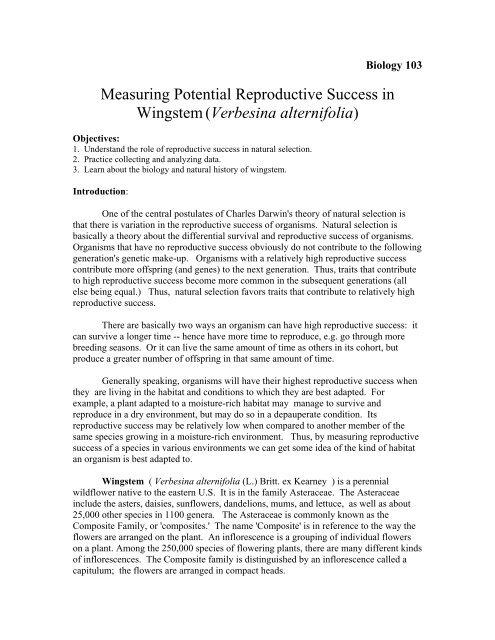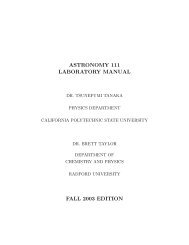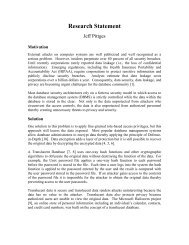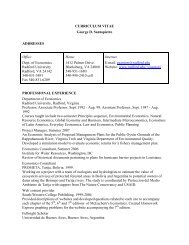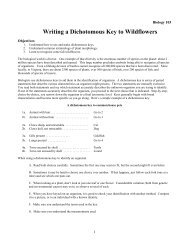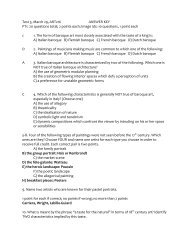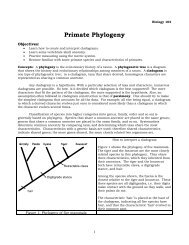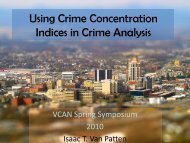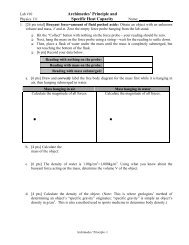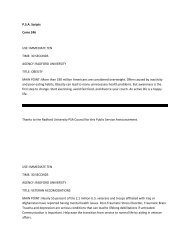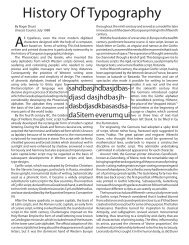Reproductive Success in Wingstem
Reproductive Success in Wingstem
Reproductive Success in Wingstem
Create successful ePaper yourself
Turn your PDF publications into a flip-book with our unique Google optimized e-Paper software.
Biology 103<br />
Measur<strong>in</strong>g Potential <strong>Reproductive</strong> <strong>Success</strong> <strong>in</strong><br />
W<strong>in</strong>gstem (Verbes<strong>in</strong>a alternifolia)<br />
Objectives:<br />
1. Understand the role of reproductive success <strong>in</strong> natural selection.<br />
2. Practice collect<strong>in</strong>g and analyz<strong>in</strong>g data.<br />
3. Learn about the biology and natural history of w<strong>in</strong>gstem.<br />
Introduction:<br />
One of the central postulates of Charles Darw<strong>in</strong>'s theory of natural selection is<br />
that there is variation <strong>in</strong> the reproductive success of organisms. Natural selection is<br />
basically a theory about the differential survival and reproductive success of organisms.<br />
Organisms that have no reproductive success obviously do not contribute to the follow<strong>in</strong>g<br />
generation's genetic make-up. Organisms with a relatively high reproductive success<br />
contribute more offspr<strong>in</strong>g (and genes) to the next generation. Thus, traits that contribute<br />
to high reproductive success become more common <strong>in</strong> the subsequent generations (all<br />
else be<strong>in</strong>g equal.) Thus, natural selection favors traits that contribute to relatively high<br />
reproductive success.<br />
There are basically two ways an organism can have high reproductive success: it<br />
can survive a longer time -- hence have more time to reproduce, e.g. go through more<br />
breed<strong>in</strong>g seasons. Or it can live the same amount of time as others <strong>in</strong> its cohort, but<br />
produce a greater number of offspr<strong>in</strong>g <strong>in</strong> that same amount of time.<br />
Generally speak<strong>in</strong>g, organisms will have their highest reproductive success when<br />
they are liv<strong>in</strong>g <strong>in</strong> the habitat and conditions to which they are best adapted. For<br />
example, a plant adapted to a moisture-rich habitat may manage to survive and<br />
reproduce <strong>in</strong> a dry environment, but may do so <strong>in</strong> a depauperate condition. Its<br />
reproductive success may be relatively low when compared to another member of the<br />
same species grow<strong>in</strong>g <strong>in</strong> a moisture-rich environment. Thus, by measur<strong>in</strong>g reproductive<br />
success of a species <strong>in</strong> various environments we can get some idea of the k<strong>in</strong>d of habitat<br />
an organism is best adapted to.<br />
W<strong>in</strong>gstem ( Verbes<strong>in</strong>a alternifolia (L.) Britt. ex Kearney ) is a perennial<br />
wildflower native to the eastern U.S. It is <strong>in</strong> the family Asteraceae. The Asteraceae<br />
<strong>in</strong>clude the asters, daisies, sunflowers, dandelions, mums, and lettuce, as well as about<br />
25,000 other species <strong>in</strong> 1100 genera. The Asteraceae is commonly known as the<br />
Composite Family, or 'composites.' The name 'Composite' is <strong>in</strong> reference to the way the<br />
flowers are arranged on the plant. An <strong>in</strong>florescence is a group<strong>in</strong>g of <strong>in</strong>dividual flowers<br />
on a plant. Among the 250,000 species of flower<strong>in</strong>g plants, there are many different k<strong>in</strong>ds<br />
of <strong>in</strong>florescences. The Composite family is dist<strong>in</strong>guished by an <strong>in</strong>florescence called a<br />
capitulum; the flowers are arranged <strong>in</strong> compact heads.
Take a daisy, as an example. What the layman often th<strong>in</strong>ks of as a s<strong>in</strong>gle daisy<br />
flower (a yellow center with white 'petals') is actually a cluster of many small flowers. In<br />
the yellow center of a daisy are many tubular disc flowers. The disc of the daisy is<br />
surrounded by many white strap-shaped ray flowers. See Figure 1. Each flower <strong>in</strong> the<br />
disc matures <strong>in</strong>to a fruit with a s<strong>in</strong>gle seed. A sunflower is put together <strong>in</strong> a similar<br />
fashion. Each of the many disc flowers <strong>in</strong> the head matures <strong>in</strong>to a fruit, i.e. what most<br />
people call a sunflower seed is actually an entire fruit conta<strong>in</strong><strong>in</strong>g a s<strong>in</strong>gle seed. A<br />
sunflower head conta<strong>in</strong>s hundreds of ripe fruits, because there were hundreds of flowers<br />
on that head. In a dandelion, the <strong>in</strong>florescence is made up entirely of ray flowers.<br />
disc flowers<br />
ray flower<br />
Figure 1: Longitud<strong>in</strong>al section through a typical <strong>in</strong>florescence of the Composite family<br />
A seed conta<strong>in</strong>s an embryonic plant of the next generation. The plant grew from a<br />
fertilized egg; the egg was fertilized by a sperm that was carried to the flower <strong>in</strong>side a<br />
pollen gra<strong>in</strong>. Once fertilization takes place, the zygote divides to form the embryonic<br />
plant while the fruit and seed mature. The embryonic plant then goes <strong>in</strong>to a state of<br />
suspended animation with<strong>in</strong> the seed. The embryo will germ<strong>in</strong>ate ( come out of<br />
suspended animation and grow) when certa<strong>in</strong> environmental conditions (hydration is<br />
often the ma<strong>in</strong> component) are met.<br />
On w<strong>in</strong>gstem both the disc and ray flowers are yellow. The ray flowers are<br />
usually sterile; sometimes they have pistils and can thus produce a fruit an a seed.<br />
W<strong>in</strong>gstem blooms from late summer to early fall. The flowers are visited primarily by<br />
long-tongued bees, especially bumblebees, and some short-tongued bees.<br />
The fruits are broad, flat, and w<strong>in</strong>ged, they are distributed to some extent by the<br />
w<strong>in</strong>d. They are dry and conta<strong>in</strong> one seed.
V. alternifolia has a central stem with longitud<strong>in</strong>al leafy w<strong>in</strong>gs, hence the<br />
common name 'w<strong>in</strong>gstem.' The stem produces long rhizomes, allow<strong>in</strong>g the plant to<br />
reproduce asexually, and the species is often found <strong>in</strong> large colonies. W<strong>in</strong>gstem grows<br />
up to 2.5 meters tall. The trivial name 'alternifolia' refers to the alternate arrangement<br />
of leaves on the stem ('altern' = alternate, 'folio' = leaf ). The leaves are up to 25 cm long<br />
and 6 cm wide and have a rough texture.<br />
Another species <strong>in</strong> this genus, V. occidentalis (L.) Walt. , is known as 'Small<br />
Yellow Crownbeard.' Like w<strong>in</strong>gstem, crownbeard has yellow flowers that bloom <strong>in</strong> the<br />
fall, so these two species can be confused if you look at them superficially. V.<br />
occidentalis, however, has opposite leaves on its stem.<br />
Figure 2: Opposite leaves<br />
Figure 3: Alternate leaves<br />
Be aware that both species are present <strong>in</strong> Radford, and make sure you have<br />
identified your plants correctly before collect<strong>in</strong>g data.<br />
In this lab you will attempt to discover which to which habitat W<strong>in</strong>gstem is best<br />
adapted. W<strong>in</strong>gstem should have the highest measured fitness <strong>in</strong> the environment to<br />
which it is best adapted.<br />
Methods: Select w<strong>in</strong>gstem plants grow<strong>in</strong>g <strong>in</strong> two different environments. Examples of<br />
some possible choices are listed below or you may choose others. You may want to<br />
discuss and decide on the habitat or conditions your want to sample as a class , so you<br />
can pool your data and thus <strong>in</strong>crease your sample size. You should discuss which of<br />
these can be practically measured <strong>in</strong> your lab period as well.<br />
Some suggest environments you may want to sample from are listed below. (These<br />
categories may be coarse ; you may want to discuss how best to categorize or quantify the<br />
environments you choose to sample. )<br />
Sun / shade<br />
north slope / south slope<br />
riparian / upland<br />
crowded / uncrowded
Discuss: As you gather data on your plant, what are some other th<strong>in</strong>gs you might want to<br />
keep track that might have an affect on the organism's reproductive success. For<br />
example, might it be valuable to measure the height of the plants or the number of leaves<br />
per plant ?<br />
Decide on how are you go<strong>in</strong>g to measure potential reproductive success. Is it best to<br />
measure number of <strong>in</strong>florescences or number of flowers ?<br />
Now that you've made some decisions, just to make sure you are aware, state exactly<br />
what will be your:<br />
Independent variable<br />
Dependent variable<br />
Variables you will try to keep constant<br />
Hypothesis<br />
Alternative hypothesis<br />
Prediction (i.e., deduction) if the hypothesis is true<br />
Prediction (i.e., deduction) if the alternative hypothesis is true<br />
Results: Here you describe and graphically represent your data. This is purely a<br />
descriptive section; you do not yet report any conclusions.<br />
You can report the descriptive statistics you have calculated, such as means, standard<br />
errors, and ranges. Graphs of your data can be <strong>in</strong>cluded here as well.<br />
If you do a correlational study , <strong>in</strong>clude those results here as well. Possible correlational<br />
studies may address these questions, among others:<br />
Does height of plants correlate with numbers of flowers per plant ?<br />
Does number of leaves per plants correlate with numbers of flowers per plant ?<br />
Conclusion and Discussion:
Ma<strong>in</strong> question to answer: In which environment does w<strong>in</strong>gstem achieve its highest<br />
potential reproductive success ? To answer this question, you first want to see whether<br />
there is a significant difference <strong>in</strong> flowers per plant <strong>in</strong> the two different environments.<br />
Often, dur<strong>in</strong>g or after a study, unforeseen problems or questions arise. Are there any<br />
problems with how this study was conducted that you could correct <strong>in</strong> a future study ?<br />
For <strong>in</strong>stance:<br />
Are there better ways to measure reproductive success <strong>in</strong> Verbes<strong>in</strong>a ? How ?<br />
Are there better ways to control the environmental conditions you studied ? How ?<br />
Verbes<strong>in</strong>a reproduces asexually by rhizomes. How doe this affect your answer as to its<br />
reproductive success, and the way you measured reproductive success ?<br />
References<br />
Mackenny, Margaret. Peterson guide to wildflowers. Houghton Miffl<strong>in</strong>; Revised<br />
edition. 1998. 448 pp.<br />
Newcomb, Lawrence. Newcomb's wildflower guide.<br />
Little, Brown. 1989. 490 pp.<br />
Smith, David G. Delaware Wildflowers 1997-2004. Accessed July 13, 2004.<br />
Available from: http://www.delawarewildflowers.org/2094.html<br />
Hilty, John. Ill<strong>in</strong>ois Wildflowers. 2002-2004 . Accessed July 13, 2004. Available<br />
from: http://www.ill<strong>in</strong>oiswildflowers.<strong>in</strong>fo/prairie/plantx/w<strong>in</strong>gstemx.htm


